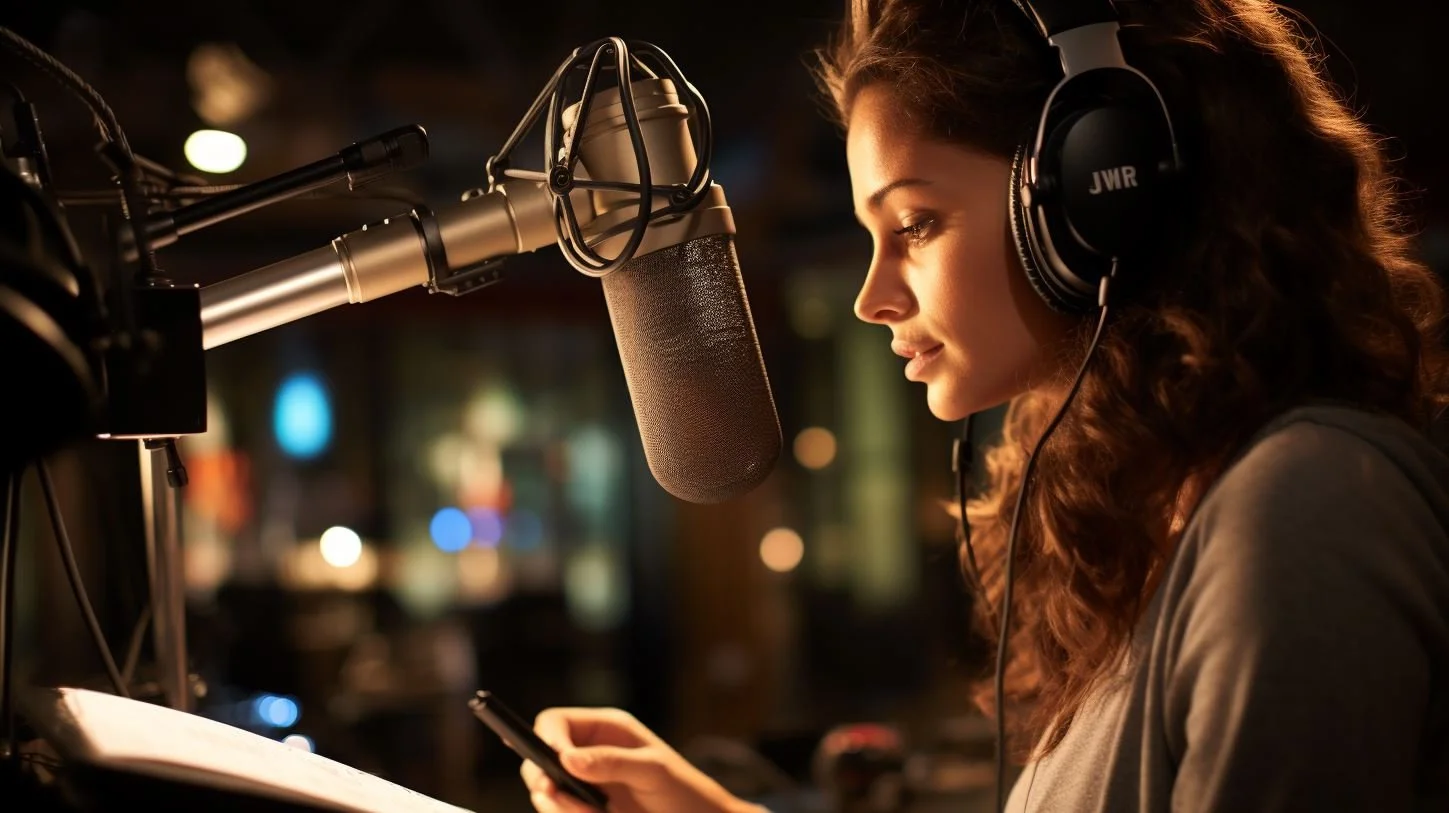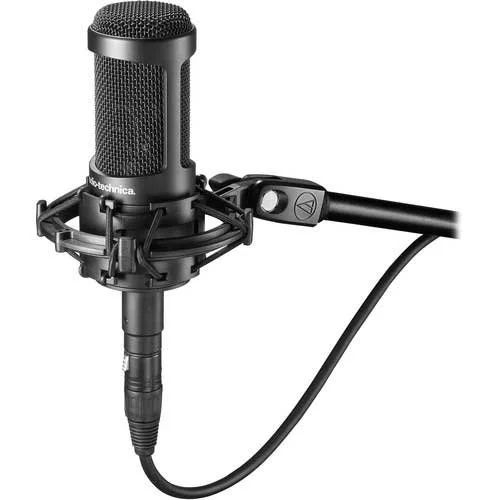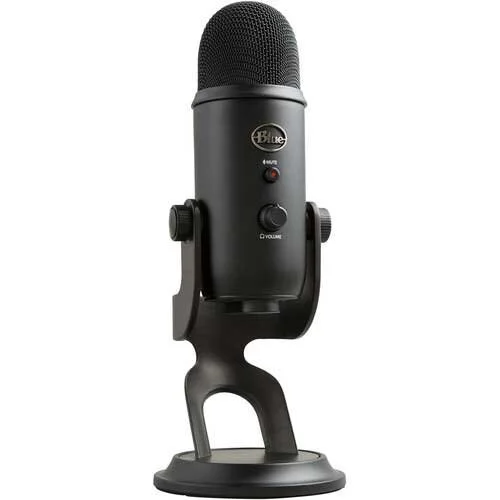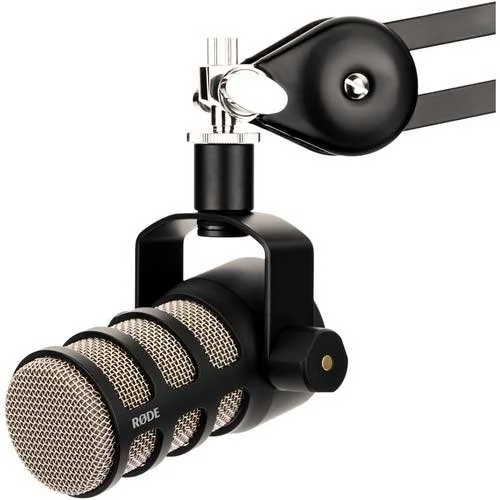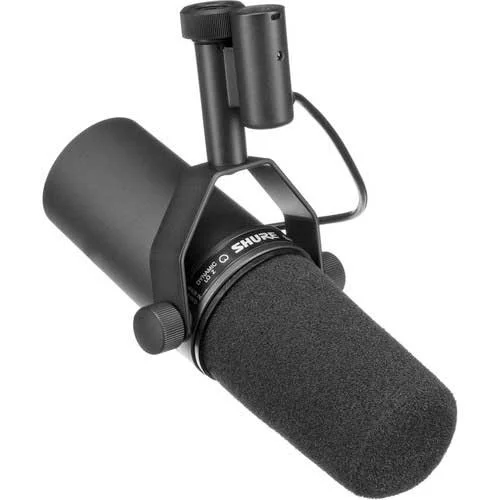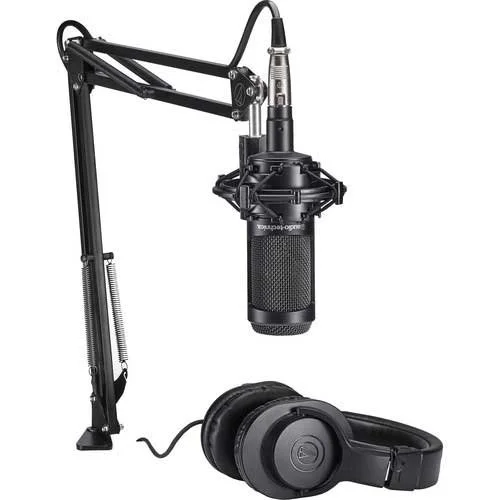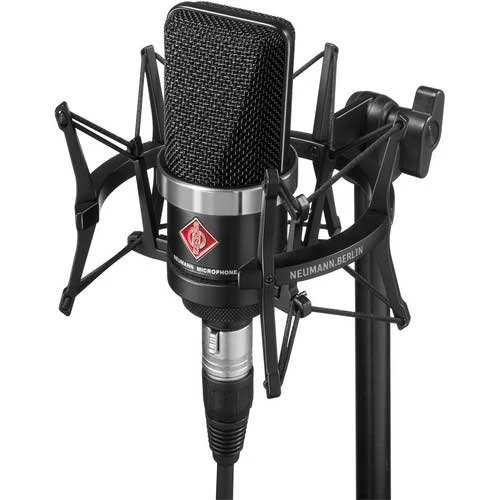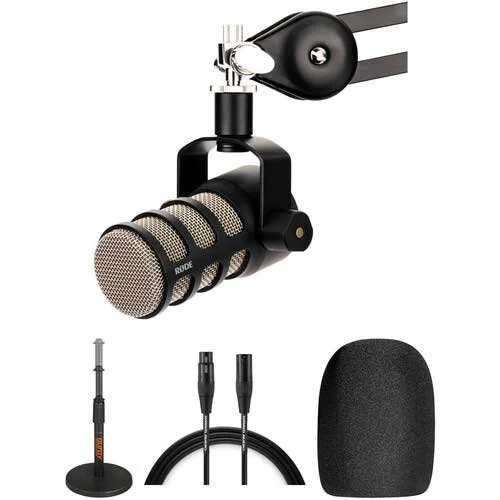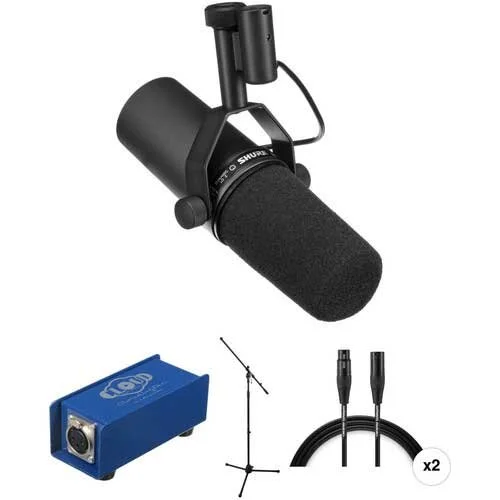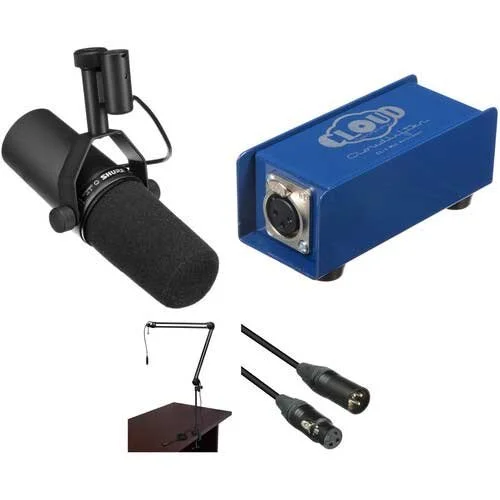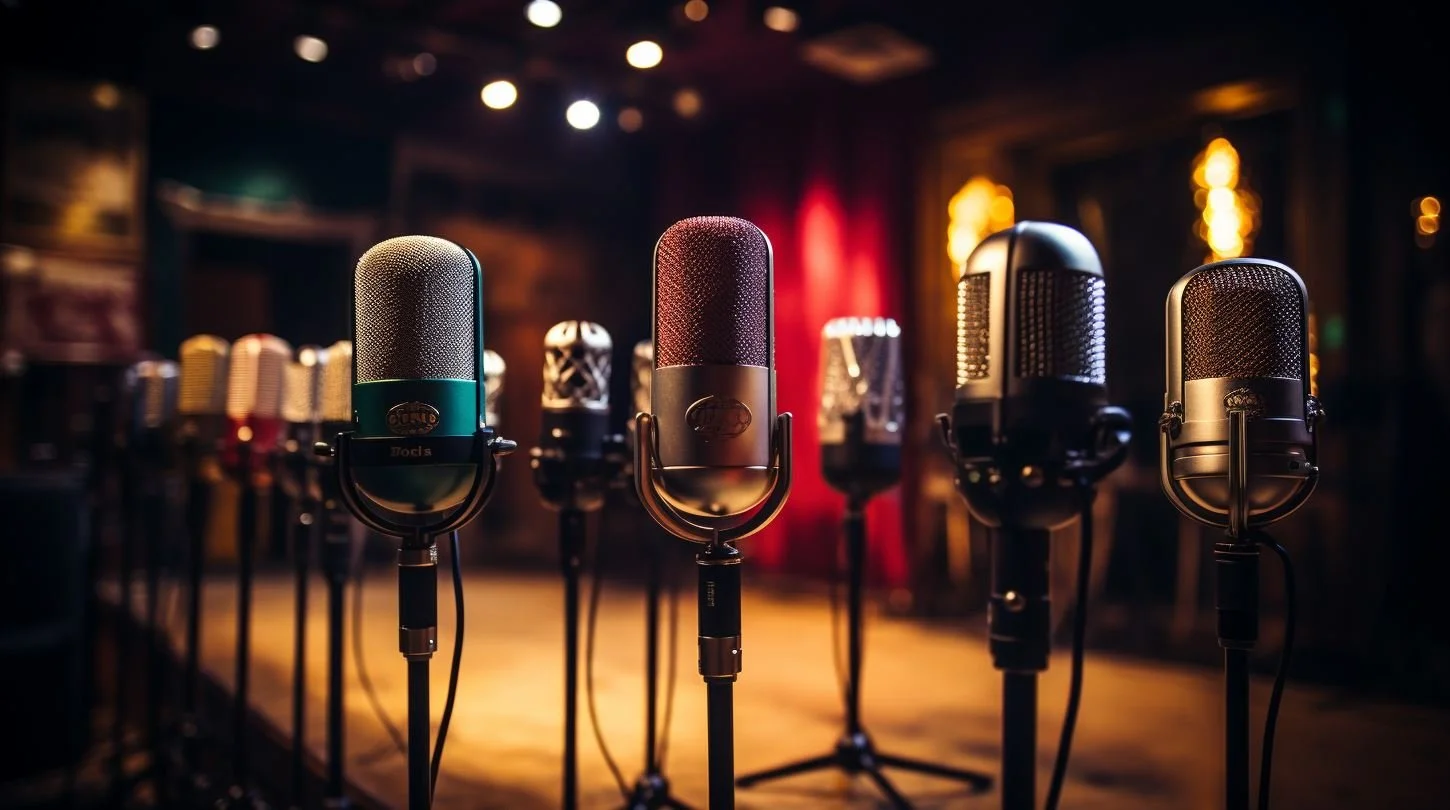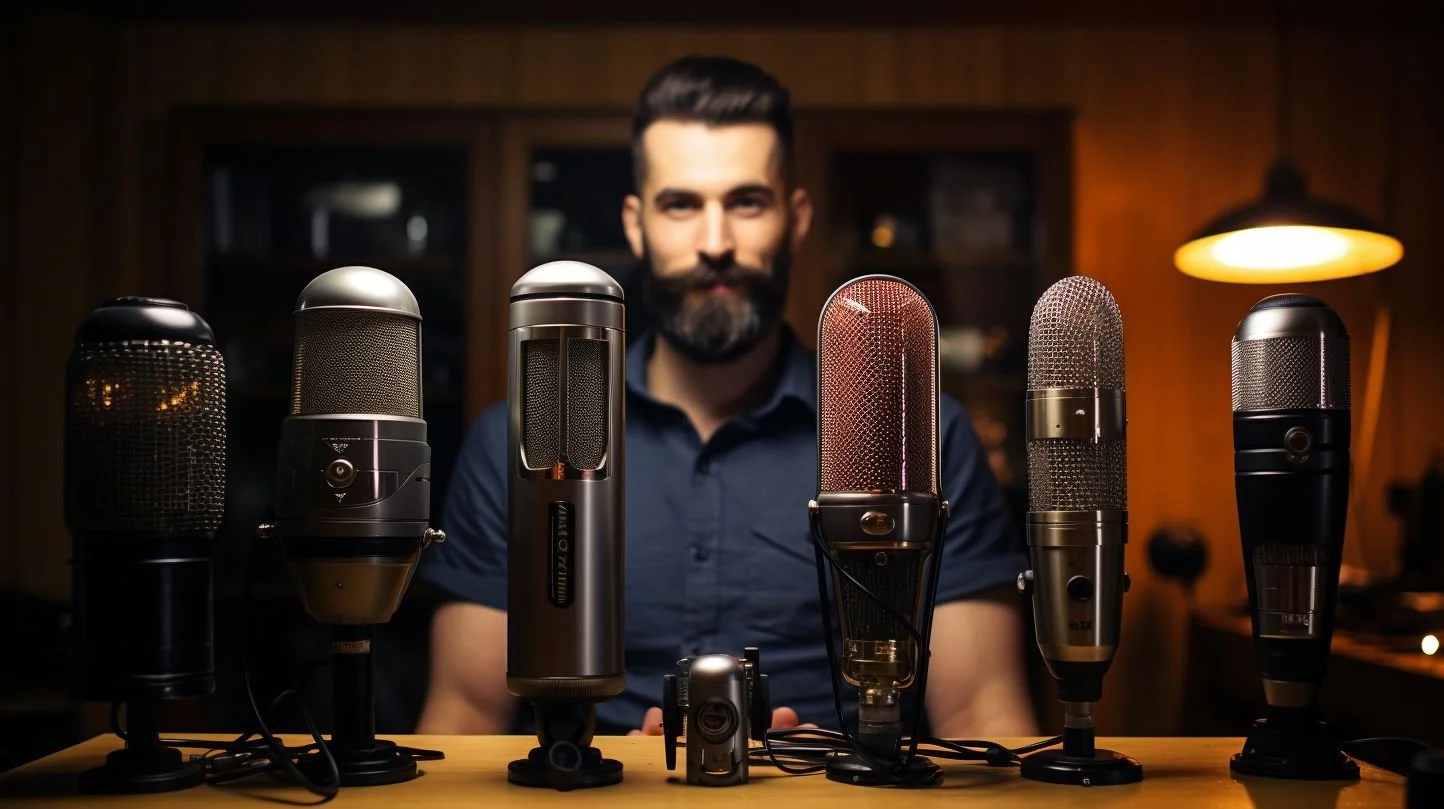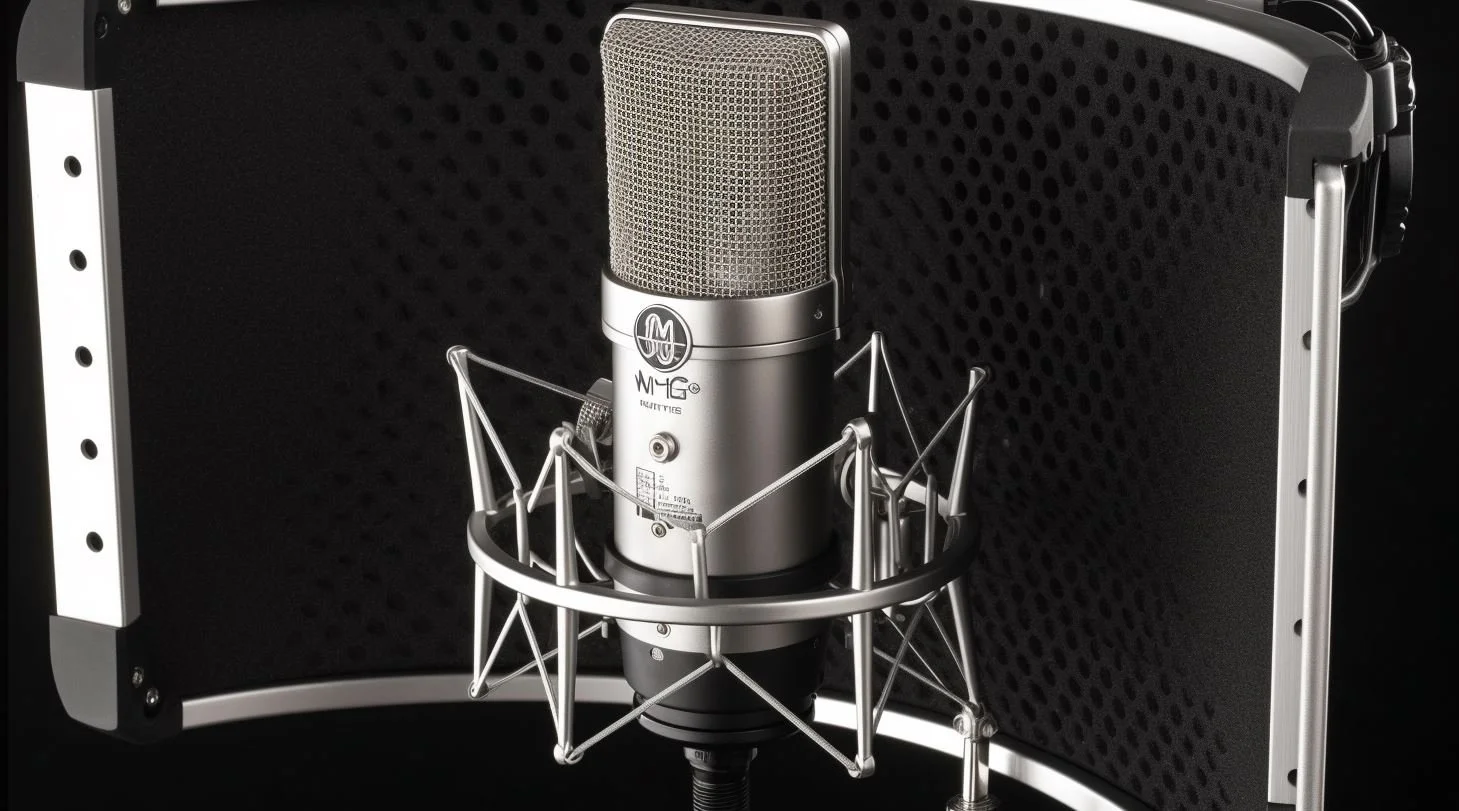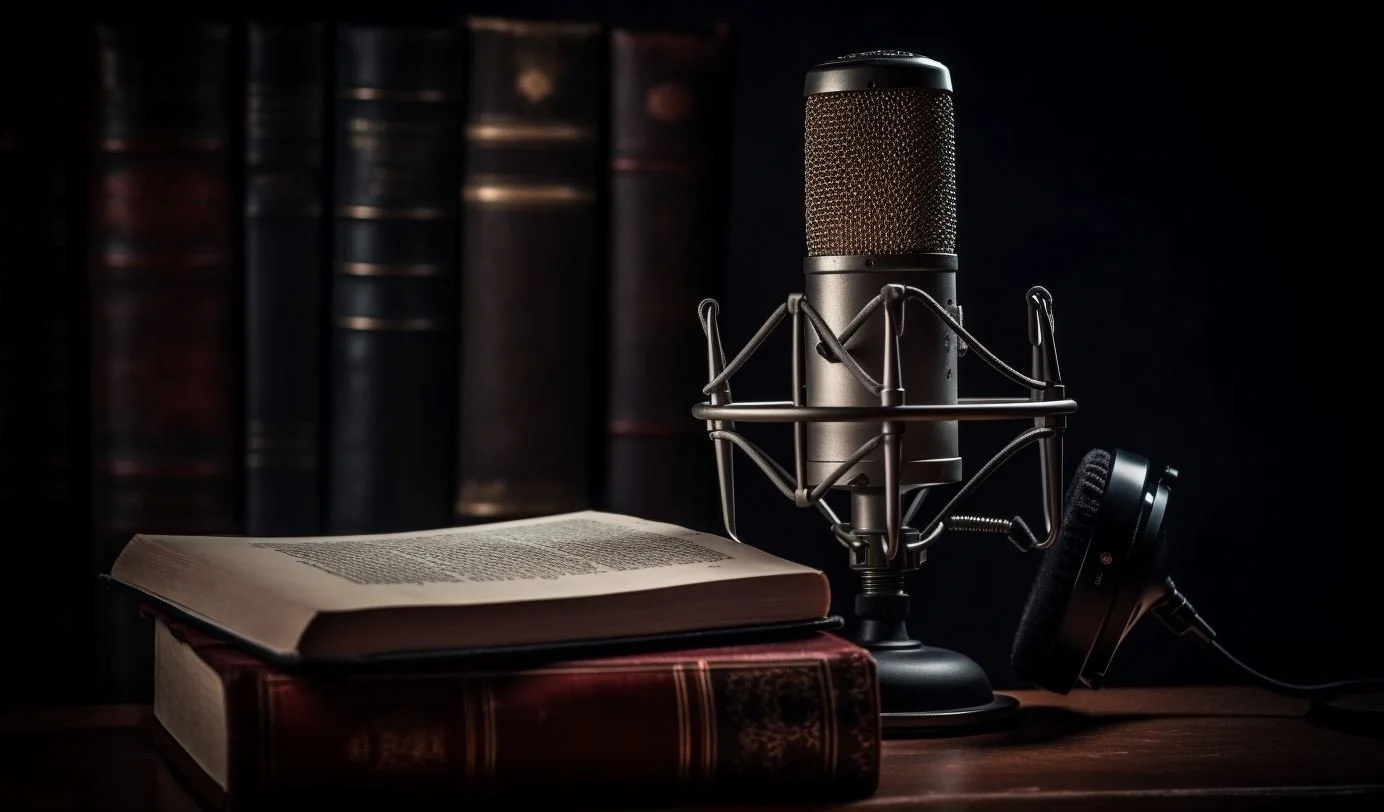Best Microphone for Narration
Navigating the Waves to Find Your Perfect Narration Companion
In the realm of narration, where precision and clarity are paramount, choosing the right microphone for narration can be a pivotal decision; the microphone you select plays a pivotal role in bringing your words to life.
In this comprehensive exploration, we delve into the nuances of microphones designed specifically for narration, dissecting their features, performance, and overall value. From condenser to dynamic, USB to XLR, the options are vast, each catering to distinct needs and preferences.
Join us on this auditory journey as we navigate through the intricate landscape of microphones, dissecting their unique attributes and guiding you towards the best microphone for narration. Whether you're seeking a tool to elevate your vocal nuances or striving for impeccable audio quality, our in-depth analysis aims to equip you with the knowledge needed to make an informed decision. Let's embark on this sonic expedition and uncover the microphone that will make your narration resonate with unparalleled excellence.
Disclaimer: This blog post contains affiliate links. If you make a purchase through one of these links, I may receive a small commission at no additional cost to you. This helps support my work and allows me to continue providing valuable content. Thank you for your support!
Read Before Buying
---
Read Before Buying ---
Condenser Vs. Dynamic Mics
For narration, there are only two choices for microphone type:
Condenser Microphones
Dynamic Microphones
Each has its strengths and weaknesses and it’s important to know which one will work best for you.
Condenser microphones are highly sensitive, require phantom power, and have less self-noise.
Strengths:
High sensitivity: Condenser mics are exceptionally sensitive and can capture subtle nuances in your voice, making them ideal for narrators.
Wide frequency response: They offer a broader frequency range, allowing for clear and accurate recording of various vocal tones.
Weaknesses:
Ambient noise sensitivity: Condenser microphones can be sensitive to ambient noises in your recording space. Using them in a controlled studio environment with minimal background noise is essential to achieve the best results.
Phantom power: Most condenser mics require 48-volt phantom power, which means you'll need a compatible audio interface or mixer to use them.
Dynamic microphones have low sensitivity, don’t require power, and have more self-noise.
Strengths:
Durability: Dynamic mics are robust and can withstand rough handling, making them suitable for portable recording setups.
Excellent off-axis rejection: They are less likely to pick up background noise and are great at isolating the intended sound source.
No need for phantom power: Dynamic microphones do not require external power sources, simplifying setup
Weaknesses:
Limited sensitivity: Dynamic microphones may not capture the same level of detail as condenser mics, which could affect the audio quality for some narration projects.
Narrower frequency response: They have a narrower frequency range compared to condenser mics, which may result in less detailed recordings.
Require a lot of gain: Due to their low sensitivity, dynamic microphones require a lot of gain to be added to their signal to achieve usable recordings. For voiceovers and narrations, dynamic mics generally need about 60dB of clean gain.
Without this gain, your recordings will be too quiet and if you try to boost the gain in post-production, you will hear lots of background hiss. Using a Fethead or Cloudlifter in tandem with a quiet preamp like the Focusrite Solo, you can achieve great results with no audible hiss.
Bottom Line: If you have access to a very quiet recording location or dedicated studio space with acoustic treatment, condenser microphones will offer you better sound quality.
If you’ll be recording in a space with ambient noise (refrigerator, HVAC ducts/fans, apartment, neighbors, etc.) dynamic microphones will offer you better sound quality.
Quick Links:
Condenser Microphones:
Best Budget: Audio Technica AT2035 - Good detail, minimal noise, an 80Hz filter, and a 10dB pad, it offers versatility and affordability for narrators.
Best Value: Rode NT1 - World-renowned large-diaphragm condenser microphone. Cardioid polar pattern, ultra-low noise (4 dB), and a wide dynamic range. With its smooth frequency response with detailed midrange and warm bass. The microphone capsule is internally shock-mounted for vibration reduction, and it comes with a high-quality suspension shock mount, pop filter, and XLR cable.
Best Overall: Neumann TLM 102 - Made in Germany from one of the premier audio brands in the world. True Neumann quality with minimal self-noise, allowing for crystal-clear recordings. Capable of handling extreme SPLs without distortion, it excels in capturing narration and a wide range of instruments. The cardioid pattern and integrated pop filter make it user-friendly for both novices and professionals.
Most Versatile: Blue Yeti - #1 best-selling USB microphone for creators. Its custom mic capsule array offers four pickup patterns, including cardioid for narration, omni for ambient recordings, figure 8 for interviews, and stereo for immersive soundscapes. With an internal shock mount and plug-and-play simplicity, the Yeti offers great value and ease of use. No phantom power, XLR cables, or audio interface required.
Dynamic Microphones:
Best Budget: Shure SM48 - A budget-friendly choice. With a cardioid dynamic design, pop filter, and rugged construction, it's perfect for narrative creators with only a little to spend.
Best Value: Rode PodMic - For value-conscious creators, the Rode PodMic delivers professional-grade audio. Its dynamic XLR design and tight cardioid polar pattern excel in capturing clear speech while reducing background noise. Compact and robust, it's an excellent choice for high-quality narration recording.
Best Overall: Shure SM7B - Renowned dynamic microphone favored by podcasters, voiceover artists, and audiobook creators. Its wide-range frequency response, shock isolation, and interference shielding ensure professional audio quality. With a classic cardioid pattern and a detachable windscreen, it's the top choice for narrators seeking reliability and top-tier performance.
Best Condenser Mics
(sorted by price from ↓↑)
Condenser microphones are much more sensitive than dynamic mics.
This makes them ideal choices for capturing the subtle nuances of your voice and high-frequency detail.
As a trade-off, they capture everything, including unwanted background noise (dogs barking, cars, planes, neighbors, etc.).
For this reason, the best results come from very quiet recording spaces or controlled studios with acoustic treatment.
Best Budget
Audio Technica AT2035
Affordable studio condenser. Ideal for narrators, providing crisp details and low noise.
| Type | Condenser |
| Polar Pattern | Cardioid |
| Frequency Range | 20 Hz to 20 kHz |
| Self-Noise | 12 dB |
| Connector | XLR |
| Weight | 14.2 oz / 403 g |
Best Value
Rode NT1
An ultra-quiet, versatile studio condenser. Ideal for pristine voiceovers and instrument recording.
| Type | Condenser |
| Polar Pattern | Cardioid |
| Frequency Range | 20 Hz to 20 kHz |
| Self-Noise | 4 dB |
| Connector | XLR |
| Weight | 10.9 oz / 308 g |
Premium
Neumann TLM 102
Legendary excellence for narration. True Neumann quality in a compact package. Expensive.
| Type | Condenser |
| Polar Pattern | Cardioid |
| Frequency Range | 20 Hz to 20 kHz |
| Self-Noise | 12 dB |
| Connector | XLR |
| Weight | 7.4 oz / 210 g |
Most Versatile
Blue Yeti
Popular USB mic, very easy to use and versatile for other audio work with 4 polar patterns to choose from.
| Type | Condenser |
| Polar Pattern | Cardioid |
| Frequency Range | 20 Hz to 20 kHz |
| Self-Noise | N/A |
| Connector | USB-A |
| Weight | 2.2 lb / 1 kg |
Best Dynamic Mics
(sorted by price from ↓↑)
Dynamic microphones are much less sensitive than condenser mics.
This makes them ideal choices for recording spaces with background noise that you don’t want to hear in the final recording.
As a trade-off, they capture less detail than condenser microphones, especially higher frequencies.
Best Budget
Shure SM48
The Shure SM48 offers budget-friendly reliability. It's a cardioid dynamic mic with an internal pop filter, perfect for narration recording.
| Type | Dynamic |
| Polar Pattern | Cardioid |
| Frequency Range | 55 Hz to 14 kHz |
| Connector | XLR |
| Weight | 13.1 oz / 370 g |
Best Value
Rode PodMic
Professional-grade audio for value-conscious creators. The Rode PodMic delivers clear, warm sound, ideal for high-quality narration recording.
| Type | Dynamic |
| Polar Pattern | Cardioid |
| Frequency Range | 20 Hz to 20 kHz |
| Connector | XLR |
| Weight | 2.1 lb / 937 g |
Best Overall
Shure SM7B
A famous dynamic microphone, perfect for narrators. Clear, natural sound, hum rejection, and pop filter included.
| Type | Dynamic |
| Polar Pattern | Cardioid |
| Frequency Range | 50 Hz to 20 kHz |
| Connector | XLR |
| Weight | 1.69 lb / 766 g |
Reviews
Audio Technica AT2035
For narrators, the Audio-Technica AT2035 is a true budget-friendly gem.
In a market flooded with USB microphones, this XLR-only condenser microphone is tailored to the needs of those recording spoken word.
Pros:
Exceptional Value: Priced around $149, the AT2035 offers remarkable quality without breaking the bank.
Perfect for Voice: Whether narrating novels, recording audiobooks, or capturing spoken word, the AT2035's cardioid polar pattern excels at delivering clear and precise vocal recordings.
Tolerance for Clear Speech: The microphone's cardioid pattern helps to isolate your voice from background noise, ensuring clean and intelligible narrations.
Shock Mount Included: The package includes a shock mount, a valuable addition for reducing vibrations and handling noise during extended recording sessions.
Cons:
Single Polar Pattern: While ideal for voice recording, its cardioid pattern may limit versatility for other applications.
Review:
The AT2035's simplicity, audio quality, and durable build make it a versatile choice for recording narratives.
Its cardioid pattern is perfect for spoken word tasks, effectively reducing unwanted background sounds, while the high-pass filter helps eliminate any low-frequency rumble.
The 10 dB pad enables it to handle louder voice passages while maintaining the nuanced qualities of a condenser microphone.
The back electret design is a plus, requiring phantom power while offering broader tolerance. It shines with voice recordings, making it an affordable choice for narration creators who demand professional results.
Kits:
Basic Kit
Basic recording kit with a boom arm for attaching to a tabletop and quality headphones for live monitoring.
Computer Recording Kit
Same as previous kit + extras. The XLR→USB adapter eliminates the need for an audio interface.
Summary:
In summary, the Audio-Technica AT2035 is a solid pick for narrators. It provides excellent value, ensuring your voice recordings are high quality.
Rode NT1
When it comes to recording narration, you need a microphone that not only captures your voice faithfully but also offers exceptional value. The Rode NT1, often regarded as the best value condenser microphone for voice-work, stands out for several reasons:
Pros:
Vintage Character: The NT1 brings a vintage character to your voice recordings, adding clarity and presence without sacrificing smoothness.
Low Noise Floor: With a remarkably low self-noise of 4.5dB EIN, the NT1 ensures your narration recordings are clean and free from distracting background noise.
Effective Shockmount: The included SMR shockmount, incorporating Rycote's patented lyre suspension technology, isolates the microphone effectively, reducing vibrations and handling noise.
Complete Kit: The NT1 Complete Recording Kit offers a comprehensive package, including the microphone, shockmount, pop screen, and more.
10-Year Warranty: Register your purchase, and Rode extends the warranty to an impressive 10 years.
Cons:
Lacks Pad and Roll-off Switches: Some users may miss the convenience of pad and roll-off switches, although this is not a significant drawback considering its price.
Review:
The NT1's tonal characteristics make it an excellent choice for narrators. Its mid-range clarity ensures your voice stands confidently at the forefront of your narrations, while the top end adds a touch of air without becoming harsh. This vintage character combines presence with smoothness, enhancing the overall listening experience.
In terms of noise performance, the NT1 excels with its extremely low self-noise. This feature allows for clean recordings, even when dealing with softer or distant sound sources. The low noise floor also gives you the freedom to shape your audio with EQ without worrying about introducing unwanted noise.
The included SMR shockmount, featuring Rycote's lyre suspension, is a standout accessory. It securely holds the microphone and pop screen in place, effectively isolating it from vibrations and handling noise. This setup not only enhances audio quality but also simplifies the recording process.
While microphone choice can be subjective, the Rode NT1 is a compelling option for narrators. Its vintage character, low-noise floor, and included accessories make it a valuable addition to any voice recording setup. Whether you're an experienced narrator or just starting your voice artist journey, the NT1 deserves a place on your shortlist.
Summary:
In a market flooded with options, the Rode NT1's balance of affordability and performance makes it a standout choice for those seeking a microphone that delivers exceptional value for story tellers. The only additional purchases you’ll need are either a portable audio recorder, or audio interface to provide phantom power to the NT1, and a boom arm or mic stand.
Neumann TLM 102
The Neumann TLM 102 is a microphone that needs no introduction in the world of professional audio.
Known for its top-notch studio microphones, Neumann has designed the TLM 102 to meet the exacting demands of voice artists.
Pros:
Superb Sound Quality: The TLM 102 delivers exceptional audio quality, capturing the nuances of your voice with remarkable clarity and detail. Its large-diaphragm design and cardioid polar pattern make it ideal for spoken-word recording.
Compact and Lightweight: Compared to some of Neumann's larger studio mics, the TLM 102 is compact and lightweight, making it easy to position and transport as needed for your narration recording sessions.
Versatile: While primarily designed for vocals, the TLM 102 proves its versatility by excelling in other applications, such as recording acoustic instruments and amplifiers.
Professional Build: Neumann's reputation for craftsmanship shines through in the TLM 102's build quality, ensuring it can withstand years of rigorous use.
Cons:
No Shockmount Included: Unlike some competing microphones in its class, the TLM 102 does not come with a shockmount included, which means an additional purchase may be necessary for optimal isolation from vibrations and handling noise.
Higher Price Point: The TLM 102 is an investment, and while it offers exceptional quality, it may be on the higher end of the budget spectrum for some users.
Review:
The Neumann TLM 102 is a transformerless capacitor microphone designed for professional audio applications.
Its fixed cardioid polar pattern is well-suited for capturing spoken word, making it an excellent choice for voice recording.
Despite its compact size, the TLM 102 packs a punch when it comes to sound quality.
It captures vocals with a sense of warmth and presence, thanks to its subtle presence lift above 6kHz. This lift enhances clarity and intelligibility without introducing any harshness to your voice.
What sets the TLM 102 apart is its versatility.
While it excels in vocal applications, it also shines when used for recording acoustic instruments, delivering a bright and lively sound with a smooth attack. Even when placed in front of a guitar amplifier, it captures the sound accurately, preserving the nuances and avoiding harsh edges.
The microphone's build quality is exemplary, showcasing Neumann's commitment to durability and reliability.
While it doesn't come with a dedicated shockmount, its design minimizes handling noise, making it suitable for studio use.
Kits:
TLM 102 + Shockmount
Exceptional narration mic. Neumann shockmount featuring 5/8"-27 female thread, adapter for 1/2"- and 3/8" stands included.
Full Studio Kit
The ultimate studio kit. Includes x1 TLM 102 mic, Rycote shockmount + pop filter, premium XLR cable, isolation filter, and a mic stand.
Summary:
The Neumann TLM 102 is a microphone that lives up to the Neumann legacy of excellence. For voice artists, it offers a level of sound quality that can elevate your recordings to a professional standard.
Its versatility, build quality, and sonic performance make it a valuable addition to any narration recording setup.
While the absence of a shockmount may require an additional investment, the TLM 102's superb sound reproduction and ability to capture the subtleties of your voice make it a compelling choice.
If you're looking for a microphone that delivers exceptional results and are willing to invest in quality, the Neumann TLM 102 deserves serious consideration for your storytelling needs.
Blue Yeti
The Blue Yeti has carved out a niche for itself as a versatile and user-friendly microphone, often recommended for podcasters and streamers.
However, it's loved features still apply in the context of voice overs.
Pros:
Plug-and-Play USB Connectivity: The Blue Yeti features USB connectivity, making it convenient to set up. You can plug it directly into a computer, and it's automatically detected by most audio software like Audacity and Audition.
In-Built Stand and Accessories: It comes with its own stand, negating the immediate need for additional purchases like a boom arm. The stand is padded with rubber, ensuring stability during recordings.
Comprehensive Controls: The microphone has intuitive dials for headphone volume, gain control, and polar pattern selection. This provides more control over your recording settings without requiring complex software manipulation.
Polar Pattern Flexibility: The Yeti offers four different polar patterns (Stereo, Cardioid, Omnidirectional, and Bidirectional). For narration, the Cardioid pattern is the best.
Built-In Headphone Jack: A 3.5mm headphone jack allows for real-time monitoring of your recordings, giving you instant feedback on the audio quality.
Sound Quality: Generally, the Yeti captures sound with good fidelity in the optimal settings, providing a clean, professional-grade recording suitable for voiceovers.
Cons:
Suboptimal Stand Height: The included stand positions the microphone relatively low, which can lead to less-than-ideal sound capture unless propped up.
Background Noise Sensitivity: Not surprisingly considering it’s a condenser mic, some users report that it picks up ambient noises or computer fan sounds if not properly configured. A quiet room is required for best results, even with the cardioid polar pattern.
Review:
The Blue Yeti’s design caters to the novice user. Its build quality is robust, with a weighty feel that lends itself to stability during use. Its aesthetics are professional enough for a home studio, and it offers the advantage of an in-built stand.
In the context of narration, sound quality is paramount. The Yeti shines when it comes to capturing clear and crisp voice recordings, especially when using the Cardioid polar pattern. This pattern helps minimize background noise by focusing on sound coming from directly in front of the microphone, making it optimal for solo narrations.
The microphone has a frequency response range of 20Hz to 20kHz, which is sufficient to capture the full spectrum of the human voice in high fidelity.
The integrated gain control is a convenient feature, as it lets you adjust the microphone's sensitivity without the need for an audio interface or DAW.
While the Blue Yeti is compatible with a variety of audio recording software, its USB-only nature limits its long-term versatility. For narrators who might consider upgrading to a more complex setup in the future, the lack of XLR connectivity could be a limitation.
Summary:
The Blue Yeti is a solid choice for entry-level narrators with a quiet space, particularly for those who value ease of use and quick setup.
Its strong suit is its good sound quality, facilitated by user-friendly controls.
Given its price point, it serves as a middle-ground option that offers better sound quality than budget microphones without requiring a steep investment.
Overall, it's a reliable option for aspiring narrators who need good quality recordings without a complex setup.
Shure SM48
The Shure SM48 has gained considerable attention for its affordability and performance, especially in live settings.
However, its utility extends beyond live performances and can be a valuable asset for those entering the field of voice artistry.
Pros:
Budget-Friendly: For newcomers in narration, the Shure SM48 presents a cost-effective option, significantly less expensive than its counterparts like the SM58.
Durability: Built to the quality one expects from Shure, the SM48 is robust and sturdy, designed to withstand physical abuse, thus ensuring longevity.
Cardioid Polar Pattern: The unidirectional cardioid polar pattern helps in isolating the source being recorded from unwanted background noise.
Less Proximity Effect: Unlike the SM58, the SM48 doesn’t have an impedance matching transformer, resulting in less proximity effect. This may help in achieving a more consistent voice capture during extended narration sessions.
Cons:
High-End Roll-Off: The microphone begins to roll off at around 10 kHz, which may result in a lack of crispness in the voice, a quality often sought after in voice overs.
Gain Requirements: The SM48 is slightly more gain-hungry compared to other models like the SM58, which means that you might require a preamp or an interface that can provide sufficient gain.
Detailed Review:
The Shure SM48 offers much value in terms of budget and performance, particularly when contrasted with higher-end microphones specifically designed for studio recording.
The cardioid polar pattern is invaluable for voice recordings. It allows the narrator to focus on the script without worrying much about room acoustics or ambient noise, as the pattern is designed to pick up sound mainly from the front of the microphone. This directional focus is vital for maintaining clarity and isolation in the recorded voice.
The frequency response of 55 Hz – 14 kHz is generally sufficient for capturing human speech, though not without some compromise.
The absence of an impedance-matching transformer makes the SM48 roll off its higher frequencies starting at 10 kHz.
While this isn’t particularly detrimental in a live setting, it may limit the microphone’s capability to capture the full richness and detail of a narrator’s voice.
This limitation is particularly important because high-frequency detail can contribute to the overall sense of presence and clarity.
However, the absence of an impedance matching transformer could help capture more consistent sounding narrations.
This exclusion contributes to a lesser proximity effect, a phenomenon where low frequencies become more pronounced as the sound source moves closer to the microphone. This can be advantageous. It allows for a more consistent vocal output during long sessions, where maintaining a consistent distance from the microphone might be challenging.
The SM48's durability should also not be underestimated. Its rugged construction ensures that the microphone can withstand regular usage, making it a reliable tool for long-term projects.
Summary:
The Shure SM48 dynamic microphone emerges as a viable choice for those getting started in narration, mainly due to its budget-friendly pricing and robust build quality.
Its cardioid polar pattern and reasonable frequency response make it a competent tool for capturing spoken word.
However, its limitations in higher frequency capture and gain requirements indicate that it may not be the most ideal for those seeking nuanced, studio-quality recordings.
Nevertheless, for narrators seeking a durable and cost-effective solution that performs adequately in voice capture, the SM48 is worthy of consideration.
Rode PodMic
Among the contenders in the affordable yet high-quality category is the Rode PodMic dynamic microphone.
Pros:
Dynamic Capsule Optimized for Speech - Equipped with a "broadcast-quality dynamic capsule" specifically designed for speech applications. Unlike condenser microphones that are sensitive to ambient sound, dynamic microphones like the PodMic are generally better at isolating the subject, making them well-suited for voice recording.
Internal Pop Filter - Plosives ("p" and "b" sounds that can cause distortion) are a common issue in voice recording. The PodMic features an integrated pop filter that effectively minimizes this problem, leading to cleaner recordings.
Durable Build and Professional Design - With its all-metal design, the PodMic is not only aesthetically appealing but also robust and durable. This is a critical factor for narrators who require equipment that can withstand long hours of usage.
XLR Connectivity - The PodMic uses a 3-pin XLR connection, offering compatibility with professional recording setups, which is generally preferred for high-quality audio capture.
Price Point - At $99, the PodMic offers excellent value for its features.
Cons:
No USB Option - The microphone does not offer a USB connection, requiring an audio interface for digital conversion. This might be a hindrance for beginners who do not already own an interface or a mixer.
Lack of Onboard Controls - Unlike some USB microphones in a similar price range, the PodMic does not have onboard controls like a gain knob or a headphone jack. This means you'll need to rely on an external mixer or audio interface for these adjustments.
No Accessories Included - The microphone does not come with a stand, boom arm, or XLR cable, necessitating additional purchases to complete your setup.
Review:
The Rode PodMic exudes professionalism with its all-metal body, making it ideal for narrators who require a robust yet stylish microphone.
However, potential users should note that the PodMic employs an XLR connection. This means that a separate audio interface is needed for digital conversion and connectivity to a computer. While this might be considered a limitation for some, it offers better scalability and is more suited for professional setups.
The Rode PodMic is engineered for vocal clarity. With its built-in pop filter, the microphone mitigates common recording issues like plosives effectively. The dynamic capsule ensures that the microphone focuses on the voice and rejects much of the ambient sound. This feature is especially advantageous for those who may not have the luxury of a soundproof studio environment.
Even though the PodMic lacks built-in audio filters, its clean sound signature offers the flexibility of post-production adjustments through EQ plugins.
Its cardioid pattern also aids in isolating the speaker, thereby offering decent sound separation, which is especially valuable when multiple microphones are used in a shared space.
Kits:
Studio Bundle
Includes x1 Rode PocMic, tabletop stand, foam windscreen, and XLR cable.
Summary:
The Rode PodMic stands as a compelling choice for narrators, particularly for those just beginning their recording journey.
It combines affordability with essential features like a dynamic capsule optimized for speech and an integrated pop filter. While it does require an additional investment in accessories and an audio interface, the microphone's durability, sound quality, and design make it a worthwhile option.
Overall, the Rode PodMic offers a balanced combination of features that meet the specialized needs of voice recording, making it a strong contender for capturing spoken word on a budget.
Rode SM7B
The Shure SM7B is a dynamic cardioid microphone that has garnered a significant following within the realms of broadcasting, podcasting, and music recording.
Originating from the line of SM ("Studio Microphone") mics, the SM7B combines robust construction with high-quality sound capture, becoming a revered tool in the professional audio world.
Its notoriety peaked when it was used in recording Michael Jackson's "Thriller" album.
However, for the specific needs of spoken word recording, which primarily involves long sessions of spoken word recording, different performance metrics must be considered.
Pros:
Excellent Vocal Clarity: The Shure SM7B offers a flat frequency response with options for bass rolloff and presence boost, enabling rich and articulate vocal reproduction.
Effective Noise Rejection: The cardioid polar pattern coupled with internal air suspension significantly mitigates off-axis and ambient noise, which is crucial in spoken word recording.
Built-in Pop Filter: With an integrated pop filter and an additional detachable windscreen, the mic effectively minimizes plosive sounds ("p" and "t" sounds), further enhancing the vocal clarity.
Durable Build: Constructed with rugged materials, the Shure SM7B promises longevity and is suited for extensive use.
Electrical Hum Rejection: Advanced internal hardware is designed to reject electrical interference, an important aspect in a recording studio where other electronic devices are in use.
Cons:
Price: With a tag around $399, it is a high-end option, and for complete functionality, additional equipment like a preamp may also be needed, driving the cost up.
Low Output Level: The Shure SM7B has a relatively low output, often necessitating a gain booster like the CL-1 Cloudlifter for optimal performance.
Single Polar Pattern: While the cardioid pattern is excellent for vocal recording, the absence of other patterns reduces the microphone's versatility for other recording scenarios.
Review:
The Shure SM7B offers a flat frequency response that yields natural vocal reproduction.
For scenarios where vocal enhancement is desired, it also provides selectable frequency response settings (bass rolloff and presence boost), thus offering a degree of flexibility in tuning the audio capture according to the narrator’s voice.
One of the challenges of voice recording is the control of ambient and mechanical noise. The cardioid polar pattern and internal air suspension in the Shure SM7B effectively handle this issue by focusing on the sound directly in front of the mic while reducing off-axis noise.
The internal pop filter and the optional detachable windscreen effectively control plosive and fricative sounds. This negates the necessity for external pop filters, making the setup less cumbersome and more streamlined.
The Shure SM7B boasts a durable and robust construction that assures longevity. Additionally, the yoke design simplifies the process of mic placement, enabling you to adjust the mic's position with just the right amount of resistance to hold it securely in place.
While the Shure SM7B offers multiple premium features, it comes at a high price point.
Moreover, its low output level often necessitates additional investment in a good preamp or a gain booster like the Fethead or Cloudlifter. It also requires an XLR interface for connection, further contributing to the overall cost.
Kits:
Mic Stand Bundle
Includes x1 SM7B, a Cloudlifter for clean gain, a mic stand, and an XLR cable.
Boom Arm Bundle
Includes x1 SM7B, a Cloudlifter, XLR cable, and a boom arm for clamping onto a table.
Summary:
The Shure SM7B is a highly efficient tool for narration, excelling in the critical areas of vocal clarity, noise rejection, and durability.
However, the microphone’s premium features come at a relatively high cost, and its low output level necessitates additional investment.
For individuals and studios who are deeply invested in voice production and are seeking a high-end, long-lasting solution, the Shure SM7B offers compelling advantages that justify the investment.
Buyer’s Guide
When it comes to narration recording, selecting the right microphone is essential to capture clear and professional audio.
Microphones come in various types, but the two most commonly used are condenser and dynamic microphones.
In this comprehensive guide, we will delve into the differences between these two microphone types, their pros and cons, and what factors to consider when making your choice.
Condenser vs. Dynamic Microphones:
Condenser:
Overview: Condenser microphones are a popular choice for narration due to their sensitivity and ability to capture detailed sound. They operate using a diaphragm that is close to a backplate, creating an electrical charge that converts sound waves into an electrical signal.
Pros:
High sensitivity: Condenser mics are exceptionally sensitive and can capture subtle nuances in your voice.
Wide frequency response: They offer a broader frequency range, allowing for clear and accurate recording of various vocal tones.
Low self-noise: Condenser microphones typically have low self-noise levels, ensuring a clean recording with minimal background hiss.
Cons:
Ambient noise sensitivity: Condenser microphones can be sensitive to ambient noises in your recording space. Using them in a controlled studio environment with minimal background noise is essential to achieve the best results.
Phantom power: Most condenser mics require 48-volt phantom power, which means you'll need a compatible audio interface or mixer to use them.
Ideal Use Cases: Condenser microphones are well-suited for controlled recording environments, such as studios or quiet home setups. However, their sensitivity to ambient noise makes them particularly suitable for environments where background noise can be minimized or controlled effectively.
Dynamic Microphones:
Overview: Dynamic microphones are known for their durability and resilience. They operate using a moving coil within a magnetic field to generate an electrical signal, making them less sensitive than condenser microphones.
Pros:
Durability: Dynamic mics are robust and can withstand rough handling, making them suitable for portable recording setups.
Excellent off-axis rejection: They are less likely to pick up background noise and are great at isolating the intended sound source.
No need for phantom power: Dynamic microphones do not require external power sources, simplifying setup.
Cons:
Limited sensitivity: Dynamic microphones may not capture the same level of detail as condenser mics.
Narrower frequency response: They have a narrower frequency range compared to condenser mics, which may result in less detailed recordings.
Ideal Use Cases: Dynamic microphones are often favored for field recording, outdoor settings, or noisy environments where noise isolation is critical. Their strong off-axis rejection makes them well-suited for environments with ambient noise or less controlled conditions, ensuring that unwanted environmental sounds are minimized in your recording.
Factors to Consider:
Recording Environment:
Consider the environment in which you'll be recording. If it's a controlled, quiet space, a condenser microphone may be your best choice. For on-the-go or noisy environments, a dynamic microphone may be more practical.
-
Creating a conducive recording environment is essential for achieving high-quality audiobook recordings.
The choice of recording environment significantly influences the audio quality captured by your microphone.
In this comprehensive guide, we will explore various aspects of creating an optimal recording environment for audiobook production.
Recording Environment:
Space Selection:
Choose a quiet and controlled space: Select a room or area that is free from external noises, such as traffic, appliances, or loud neighbors. Soundproofing or acoustic treatment can help reduce unwanted background noise.
Room size:
A smaller room with minimal echo is generally preferred for audiobook recording. However, if you have access to a larger space, consider using portable acoustic panels to control sound reflections.
Soundproofing and Acoustic Treatment:
Soundproofing: Soundproofing measures, such as sealing gaps, adding weather stripping, or installing acoustic curtains, can help reduce external noise intrusion. Consider double-glazed windows for additional sound isolation.
Acoustic treatment: Acoustic treatment involves the use of sound-absorbing materials, diffusers, and bass traps to control reflections and create a neutral sound environment. Place absorptive panels strategically on walls, ceilings, and floors to minimize echoes and reverberations.
Furniture and Layout:
Minimalist approach: Keep the recording space clutter-free to minimize sound reflections and obstructions. Arrange furniture to avoid sound bouncing off surfaces or causing unwanted noise.
Isolation: Use an isolated table or desk for your recording setup to prevent vibrations from reaching the microphone. A shock mount for your microphone can further reduce vibrations.
Ventilation and Temperature Control:
Ventilation: Ensure proper ventilation in your recording space to prevent discomfort during long recording sessions. Use quiet fans or air conditioning systems that produce minimal noise.
Temperature control: Maintain a comfortable temperature in the room to prevent discomfort and minimize potential noise from HVAC systems.
Background Noise Elimination:
Power down electronics: Turn off or disconnect electronic devices that may emit background noise, such as computers, printers, or fans.
Schedule recordings: If possible, schedule recording sessions during times when external noise sources, like lawnmowers or construction, are less active.
Microphone Placement and Monitoring:
Position your microphone correctly: Experiment with microphone placement to find the optimal position that captures your voice's full tonal range while minimizing room reflections.
Monitoring: Use closed-back headphones for real-time monitoring during recording. This allows you to detect and address any audio issues as you record.
Sound Tests and Adjustments:
Before recording, perform sound tests and listen for any issues like echoes, background noise, or other anomalies. Make necessary adjustments to your recording environment and setup to ensure optimal audio quality.
In conclusion, the recording environment plays a pivotal role in achieving high-quality audiobook recordings.
A quiet, well-controlled space with proper soundproofing and acoustic treatment is essential to minimize unwanted noise and reflections.
By paying attention to room selection, layout, ventilation, and background noise elimination, you can create an ideal recording environment that enhances the clarity and professionalism of your audiobook recordings.
Proximity Effect:
One critical aspect to consider when selecting a microphone for voice recording is the microphone's polar pattern and how it interacts with the proximity effect, particularly in the case of cardioid microphones.
Proximity Effect: The proximity effect is a phenomenon where a microphone, especially one with a cardioid pickup pattern, exhibits an increase in bass or low-frequency response as the sound source gets closer to the microphone. This means that when you speak or narrate very closely to a cardioid microphone, your voice may sound deeper and warmer due to the emphasis on lower frequencies.
Tonal Control: While the proximity effect can add richness to your voice and enhance the depth of your narration, it's essential to use it judiciously. Depending on your voice and the intended tone of your narration, you may choose to vary your microphone distance to achieve the desired tonal quality. Experiment with microphone placement to find the right balance between warmth and clarity.
Awareness and Skill: Being aware of the proximity effect and how it affects your voice can be a valuable tool in your voice artist arsenal. Skilled narrators often adjust their microphone distance strategically to control the tonal characteristics of their voice, ensuring that it aligns with the content and mood of the project.
When choosing a microphone, particularly if you prefer the sound of the proximity effect, consider cardioid microphones with a well-defined and controlled low-end response. This allows you to utilize the proximity effect to your advantage while maintaining a balanced and professional recording.
-
Understanding the concept of proximity effect is crucial when choosing the best microphone for audiobook recording.
Proximity effect refers to the change in a microphone's frequency response when the sound source (in this case, your voice) gets closer to the microphone.
In this comprehensive buyer's guide, we will explore proximity effect, its implications, and how to use it effectively in audiobook recording.
Proximity Effect:
Definition:
Proximity effect is a phenomenon where a microphone's bass or low-frequency response increases as the sound source gets closer to the microphone. It is most noticeable in directional microphones like cardioid, supercardioid, and hypercardioid patterns.
Implications for Audiobook Recording:
Tonal Variation: When you speak or narrate very closely to a microphone, the proximity effect can cause your voice to sound deeper and warmer due to the emphasis on lower frequencies. This effect can add richness to your voice, which can be desirable for certain audiobook projects.
Control and Artistic Expression: Understanding and controlling proximity effect can be a valuable tool for narrators. By varying your microphone distance strategically, you can modulate the tonal characteristics of your voice to suit the content and mood of the audiobook. For instance, speaking closer to the microphone for intimate scenes or moving slightly away for dramatic moments can help convey the intended emotions.
Microphone Selection: Different microphones exhibit varying degrees of proximity effect. When selecting a microphone for audiobook recording, consider the proximity effect as part of your decision-making process. Test different microphones to find one that complements your voice and desired tonal qualities.
Effective Use of Proximity Effect:
Mic Placement: Experiment with microphone placement to control the proximity effect. Speaking very close to the microphone (typically within a few inches) enhances the bass response, while moving slightly farther away reduces its impact.
Adjusting for Intensity: For sections of the audiobook where you want a warmer or more intimate tone, get closer to the microphone. Conversely, when you want a crisper or more neutral sound, maintain a bit more distance from the microphone.
Consistency: Maintain a consistent microphone distance throughout recording to ensure uniform tonal quality throughout the audiobook.
Microphone Polar Patterns:
Different microphone polar patterns, such as cardioid, omnidirectional, or figure-8, can exhibit proximity effect differently. Cardioid patterns tend to accentuate the effect, while omnidirectional patterns exhibit it less. Experiment with microphone patterns to find the one that best suits your voice and desired sound.
In conclusion, understanding proximity effect is essential when choosing the right microphone and employing effective microphone techniques for audiobook recording. By strategically controlling your microphone distance and considering microphone polar patterns, you can harness the power of proximity effect to enhance the depth and emotional impact of your audiobook narration.
Budget:
Condenser microphones tend to be more expensive than dynamic ones. Determine your budget and choose a microphone that offers the best value for your needs.
-
Budget considerations are a crucial aspect of choosing the best microphone for audiobook recording.
Setting a realistic budget allows you to narrow down your options and make an informed decision based on your financial resources.
In this comprehensive guide, we will explore various factors related to budget when selecting a microphone for audiobook recording.
Budget Considerations:
Define Your Budget:
Before diving into microphone options, determine a specific budget range that you are comfortable with. Setting a clear budget will help you narrow down choices and prevent overspending.
Microphone Pricing Ranges:
Microphones come in a wide range of price points, from budget-friendly options to high-end models. Here are some general price ranges to consider:
Budget Microphones: These microphones are typically priced under $100 and offer good value for basic recording needs. While they may not have all the features of higher-end models, they can provide satisfactory audio quality for many applications.
Mid-Range Microphones: In the $100 to $500 range, you can find a wide variety of microphones that offer excellent performance and versatility. Many professional-quality microphones fall into this category, making it a popular choice for audiobook recording.
High-End Microphones: Microphones priced above $500 are often considered premium options with top-tier audio quality and features. These are typically used in professional studios and may be overkill for most audiobook recording purposes.
Balancing Budget and Quality:
While it's tempting to seek the best microphone within your budget, keep in mind that other factors, such as your recording environment and technique, also influence audio quality. A more expensive microphone may not always guarantee significantly better results if other elements are lacking.
Consider investing in essential accessories like pop filters, shock mounts, or acoustic treatment, as they can enhance audio quality and recording efficiency without breaking the bank.
Used or Refurbished Microphones:
Buying used or refurbished microphones can be a cost-effective way to acquire high-quality equipment within your budget. Be sure to research the condition of the microphone and purchase from reputable sellers or manufacturers.
Value for Money:
Focus on getting the best value for your budget rather than simply seeking the cheapest option. Consider factors like microphone durability, versatility, and compatibility with your recording setup when making a decision.
Future Upgrades:
Think about your long-term goals and whether you plan to upgrade your microphone in the future. Choosing a versatile microphone within your budget can save you from needing to replace it as your skills and recording needs evolve.
In conclusion, budget considerations are a crucial aspect of selecting a microphone for audiobook recording.
Defining your budget, understanding pricing ranges, and balancing budget and quality will guide you towards a microphone that meets your recording needs without overspending.
Keep in mind that value for money, used options, and long-term planning are key factors in making a budget-conscious decision that aligns with your audiobook recording goals.
Durability:
If you need a microphone that can withstand rough handling, dynamic microphones are a better choice. If you can ensure careful handling, a condenser microphone can deliver excellent results.
-
Durability is a key consideration when choosing the best microphone for audiobook recording.
A durable microphone ensures reliable performance over time and provides a sound investment for your recording needs.
In this guide, we will explore the importance of durability in microphones and factors to consider when assessing a microphone's build quality.
Durability in Microphones:
Build Quality:
The build quality of a microphone is a crucial factor in its durability. Microphones with robust construction materials, such as metal housings and quality components, tend to withstand wear and tear better than those with plastic components. Pay attention to the overall build quality of the microphone.
Handling and Portability:
If you plan to use your microphone for portable recording or on-location sessions, consider a microphone designed for durability during transport. Look for features such as a rugged carrying case or protective foam padding to prevent damage during transit.
Shock Mounts and Isolation:
Microphones that come with shock mounts or have built-in shock absorption mechanisms are better at handling physical vibrations and handling noise. These features contribute to both the microphone's longevity and the quality of your recordings.
Connector Durability:
Check the durability of the microphone's connectors, especially the XLR connectors used for connection to audio interfaces or mixers. High-quality connectors are less prone to wear and damage, ensuring a reliable connection over time.
Phantom Power:
Check if your recording setup can provide phantom power for a condenser microphone. If not, a dynamic microphone may be a more straightforward choice.
-
Phantom power is a critical consideration when choosing a microphone for audiobook recording, especially if you opt for a condenser microphone.
Understanding phantom power, its purpose, and how it impacts microphone selection and performance is essential.
In this guide, we will explore the significance of phantom power in microphones and its relevance to audiobook recording.
Phantom Power:
Definition:
Phantom power, often labeled as +48V or P48, is a direct current (DC) electrical voltage supplied to a microphone through its audio cable. It is typically provided by an audio interface, mixer, or microphone preamplifier.
Purpose of Phantom Power:
Phantom power serves two primary purposes:
Powering Condenser Microphones: Most condenser microphones require phantom power to operate. This voltage energizes the microphone's internal electronics, allowing it to generate an electrical signal from sound waves.
Activating Electret Condenser Microphones: Electret condenser microphones have a permanent electrical charge and require phantom power to activate internal electronics that improve their performance.
Microphone Compatibility:
Condenser Microphones: If you plan to use a condenser microphone for audiobook recording, ensure that your audio interface or mixer can supply phantom power. Condenser microphones are known for their sensitivity and high-quality audio capture, making them popular choices for audiobook narration.
Dynamic Microphones: Dynamic microphones, on the other hand, do not require phantom power, as they generate a signal through electromagnetic induction. They are more forgiving in terms of power requirements and are known for their durability.
Phantom Power Supply:
Ensure that your recording setup includes a reliable source of phantom power. Most audio interfaces and mixers provide phantom power options on their microphone inputs. Check the specifications and documentation of your equipment to confirm its phantom power capabilities.
Phantom Power Compatibility:
Verify that the microphone you select is compatible with the phantom power supply voltage of your audio equipment.
The standard phantom power voltage is +48V, but some microphones may require lower voltages like +12V or +24V.
Always match the microphone's voltage requirements with the available phantom power.
Phantom Power Safety:
Be cautious when connecting or disconnecting microphones with phantom power engaged, as it can produce a loud popping sound that may damage your equipment or hearing. It is advisable to power off the phantom power before plugging or unplugging microphones.
Phantom Power Alternatives:
If you encounter a situation where phantom power is unavailable or inconvenient, you can explore alternative power options such as battery-powered preamplifiers or microphones with their power sources.
Sound Preference:
Consider the tone and character of the microphone. Each microphone type has its unique sound, so listen to samples and choose the one that best suits your voice and style.
-
Sound preference plays a pivotal role when selecting the best microphone for audiobook recording.
The microphone's ability to capture and reproduce sound in a way that aligns with your preferences is crucial for achieving the desired audio quality.
In this guide, we will explore the significance of sound preference in microphone selection and how to choose a microphone that suits your unique auditory preferences for audiobook recording.
Sound Preference:
Understanding Sound Characteristics:
Sound preference is highly subjective and varies from person to person. To make an informed choice, it's essential to understand the key sound characteristics that microphones can influence:
Tonal Balance: This refers to the distribution of frequencies in the recorded sound. Some microphones may emphasize certain frequency ranges, making the audio sound warmer or brighter.
Sensitivity: Microphones can differ in their sensitivity to sound sources. A more sensitive microphone may capture subtle nuances and details, while a less sensitive one may provide a more balanced or flat response.
Transparency: Transparency refers to how accurately a microphone reproduces the original sound without coloration or distortion. Some microphones are known for their transparency, while others add a specific character or color to the audio.
Noise Handling: Different microphones have varying noise levels or self-noise. A quieter microphone can capture clean audio, especially during silent passages.
Microphone Types and Sound Characteristics:
Condenser Microphones: Condenser microphones are known for their sensitivity and ability to capture detailed nuances in sound. They often excel at providing a transparent and clear audio representation. However, the tonal balance can vary among condenser microphones, with some leaning toward brightness and others toward warmth.
Dynamic Microphones: Dynamic microphones are generally less sensitive than condenser microphones and offer a more balanced and robust sound. They are less likely to add coloration to the audio and are known for their reliability in capturing spoken word.
Personal Sound Preference:
Consider your personal sound preference when selecting a microphone. Do you prefer a warmer, richer tone, or do you lean towards a brighter and more detailed sound? Your preference will guide you towards the microphone type and model that suits your auditory tastes.
Listening with Headphones:
Use high-quality headphones to monitor and evaluate microphone sound during recording and playback. This allows you to discern subtle differences in sound and make necessary adjustments to meet your preferences.
Accessories:
Accessories play a crucial role in optimizing your condenser microphone setup for voiceover recording. Here are some essential accessories to consider:
Pop Filters: Pop filters are indispensable for reducing plosive sounds (like "p" and "b" sounds) and sibilance that can cause unwanted audio artifacts. They are inexpensive and can significantly improve recording quality.
Shock Mounts: A shock mount suspends the microphone, isolating it from vibrations and handling noise. This accessory is particularly useful if you're using a sensitive condenser microphone, as it helps maintain a steady recording without disturbances. Recommended shock mounts →
Boom Arms and Stands: A sturdy microphone stand or boom arm is essential for positioning your microphone at the correct height and angle. This ensures that you can maintain a consistent distance and angle while speaking. Recommended boom arms →
Acoustic Treatment: Depending on your recording environment, acoustic treatment, such as foam panels and bass traps, can help control room reflections and reduce background noise. These treatments can enhance audio quality by minimizing unwanted reverberations.
Cables: High-quality XLR cables are essential for connecting your condenser microphone to your audio interface or mixer. Ensure that the cables are of sufficient length and well-insulated to prevent signal interference. Recommended XLR cables →
Phantom Power Supply: If your audio interface or mixer does not provide phantom power (48 volts) and your condenser microphone requires it, consider purchasing a standalone phantom power supply to ensure proper microphone operation. Recommended recorders →
Headphones: Quality headphones are essential for real-time monitoring during recording. Closed-back headphones can help isolate your voice from external sounds, allowing you to assess your narration accurately. Recommended headphones →
External Preamp: Depending on your microphone and audio interface, an external microphone preamplifier can further enhance the microphone's performance by providing clean gain and improving the signal-to-noise ratio.
Recording Software: Ensure that you have suitable audio recording and editing software to capture and edit your recordings. Popular choices include Adobe Audition, Audacity, and Pro Tools.
Storage: Invest in reliable storage solutions to safeguard your recordings. Consider external hard drives or cloud storage for backup and archival purposes. Recommended storage →
These accessories may add to the initial cost of your setup, but they can significantly impact the quality of your work. Evaluate your specific needs and budget to determine which accessories are essential for your setup.
-
Accessories are integral to optimizing your microphone setup for audiobook recording.
They not only enhance audio quality but also improve overall recording efficiency and professionalism.
In this guide, we will explore essential accessories to consider when setting up your microphone for audiobook recording.
Accessories for Audiobook Recording Microphones:
Pop Filters:
Purpose: Pop filters are used to reduce plosive sounds (e.g., "p" and "b" sounds) and sibilance (harsh "s" and "sh" sounds) that can cause unwanted audio artifacts during recording.
Placement: Position the pop filter between your mouth and the microphone at a distance of about 2-4 inches to effectively reduce plosives and sibilance.
Shock Mounts:
Purpose: Shock mounts suspend the microphone, isolating it from vibrations and handling noise. They are especially valuable for condenser microphones and enhance audio quality by preventing unwanted vibrations.
Compatibility: Ensure that the shock mount is compatible with your microphone's size and type.
Boom Arms and Stands:
Purpose: Sturdy microphone stands or boom arms are essential for positioning your microphone at the correct height and angle. This ensures that you can maintain a consistent microphone distance during recording.
Adjustability: Opt for adjustable boom arms or stands that allow you to fine-tune the microphone's position for optimal recording.
Acoustic Treatment:
Purpose: Acoustic treatment includes sound-absorbing materials, diffusers, and bass traps that control sound reflections and minimize background noise. These treatments improve audio quality by reducing echoes and reverberations.
Placement: Install absorptive panels on walls, ceilings, and floors in your recording space to effectively control room acoustics.
Ventilation and Temperature Control:
Purpose: Proper ventilation and temperature control maintain a comfortable recording environment, preventing discomfort during long recording sessions and minimizing potential noise from HVAC systems.
Quiet Equipment: Use quiet fans or air conditioning systems that produce minimal noise to maintain an optimal recording environment.
Background Noise Elimination:
Purpose: Turn off or disconnect electronic devices that may emit background noise, such as computers, printers, or fans, to ensure clean audio recordings.
Headphones:
Purpose: High-quality closed-back headphones are essential for real-time monitoring during recording. They allow you to assess your narration accurately, detect issues, and make necessary adjustments.
Isolation: Closed-back headphones provide isolation from external sounds, enhancing your ability to focus on your recording.
External Preamp:
Purpose: An external microphone preamplifier can enhance your microphone's performance by providing clean gain and improving the signal-to-noise ratio.
Compatibility: Ensure that the preamp is compatible with your microphone and recording setup.
Recording Software:
Purpose: Quality recording and editing software is essential for capturing and editing your audiobook recordings. Popular options include Adobe Audition, Audacity, and Pro Tools.
Compatibility: Choose software that is compatible with your computer operating system and audio interface.
Storage:
Purpose: Invest in reliable storage solutions to safeguard your audiobook recordings. Consider external hard drives or cloud storage for backup and archival purposes.
Narration Microphone Recommendations:
Condenser Microphones:
Best Budget: Audio Technica AT2035 - Good detail, minimal noise, an 80Hz filter, and a 10dB pad, it offers versatility and affordability for narrators.
Best Value: Rode NT1 - World-renowned large-diaphragm condenser microphone. Cardioid polar pattern, ultra-low noise (4 dB), and a wide dynamic range. With its smooth frequency response with detailed midrange and warm bass. The microphone capsule is internally shock-mounted for vibration reduction, and it comes with a high-quality suspension shock mount, pop filter, and XLR cable.
Best Overall: Neumann TLM 102 - Made in Germany from one of the premier audio brands in the world. True Neumann quality with minimal self-noise, allowing for crystal-clear recordings. Capable of handling extreme SPLs without distortion, it excels in capturing narration and a wide range of instruments. The cardioid pattern and integrated pop filter make it user-friendly for both novices and professionals.
Most Versatile: Blue Yeti - #1 best-selling USB microphone for creators. Its custom mic capsule array offers four pickup patterns, including cardioid for narration, omni for ambient recordings, figure 8 for interviews, and stereo for immersive soundscapes. With an internal shock mount and plug-and-play simplicity, the Yeti offers great value and ease of use. No phantom power, XLR cables, or audio interface required.
Dynamic Microphones:
Best Budget: Shure SM48 - A budget-friendly choice. With a cardioid dynamic design, pop filter, and rugged construction, it's perfect for narrative creators with only a little to spend.
Best Value: Rode PodMic - For value-conscious creators, the Rode PodMic delivers professional-grade audio. Its dynamic XLR design and tight cardioid polar pattern excel in capturing clear speech while reducing background noise. Compact and robust, it's an excellent choice for high-quality narration recording.
Best Overall: Shure SM7B - Renowned dynamic microphone favored by podcasters, voiceover artists, and audiobook creators. Its wide-range frequency response, shock isolation, and interference shielding ensure professional audio quality. With a classic cardioid pattern and a detachable windscreen, it's the top choice for narrators seeking reliability and top-tier performance.
Conclusion:
Throughout this article, we have examined seven distinct microphones, each demonstrating specific attributes that make them well-suited for narration.
These recommendations are grounded in rigorous professional testing and evaluation, offering a spectrum of options to meet various needs and budgets.
The accompanying buyer’s guide serves as an educational resource, illuminating essential factors like frequency response, polar patterns, and the signal-to-noise ratio. Understanding these technical elements can greatly assist you in making an informed purchasing decision that aligns with your specific requirements.
Choosing a microphone for spoken word is not merely a technical decision but also a creative one. It's about finding that perfect symbiosis between your voice and the microphone, where the nuances of your vocal delivery are captured most authentically and compellingly.
A suitable microphone, therefore, is not just a tool but an extension of your creative expression.
As you take the next steps narration recording journey, we hope this article serves as a reliable resource that not only guides your purchase but also enriches your understanding of the intricate world of audio production.
The objective is not just to point you to a product but to empower you with the knowledge to discern what will serve you best in the long term.
Thank you for reading.
Follow Me On:
Share this post to help the website grow.

